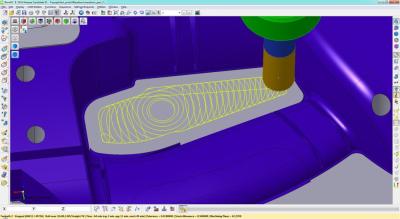
WorkNC CAM Software's latest 2016 version integrates Vero Software’s innovative Waveform technology to reinforce its key assets of toolpath reliability, time savings, cost reduction and high surface quality.
Miguel Johann, WorkNC product manager, says: "Our Development Team worked tirelessly for the past 12 months to bring us WorkNC 2016, a version based on more modern technologies, from the tools we use internally and the methodology we use to develop software, to new manufacturing techniques like Vero's Waveform constant cutter engagement and Vero's Client License Server, CLS. WorkNC 2016 offers more stability and reliability to the everyday use of WorkNC, increasing the comfort of our users with ergonomic improvements to the product's interface."
The Waveform technology, developed over several years by Vero Software, significantly improves standard roughing strategies by removing a consistent amount of material while preserving machine and tool service life.
To maintain a constant load on the cutter, the strategy consists of machining from the stock material towards the part geometry. This approach results in a reduced number of intermittent cutting movements, especially in the outer areas, meaning that the tool stays engaged in the material for as long as possible and leads to fewer retracts and air cutting periods.
The step-over distance automatically adjusts to maintain a constant load on the cutter over the complete toolpath trajectory, making it possible to maintain optimal feed rates during the whole cycle, which can attain rates of up to five times faster than a traditional roughing strategy. Machining is performed over the full cutting length of the tool (whenever possible), which distributes load evenly.
Combined with the WorkNC Collision Detection module, which allows detecting collisions and out-of-limit conditions in the whole machining environment, the Waveform technology offers highly secured and reliable toolpaths that improve quality while maintaining high productivity level.
Still aiming at reducing time cycles and improving surface quality, WorkNC 2016 enhances its wall machining strategy with a lace cycle used with the appropriate tools.
Without this lace option, machining is done from top to bottom, and the tool moves up in rapid feed rate.
With the Lace option, the first pass is done from top to bottom, and the next pass is done from bottom to top. The toolpath is shorter, with less retracts, machining time is therefore reduced.
In WorkNC 2016, it is now even easier to select the different commands in the graphical user interface and commands are now at the users' fingertips. The WorkNC 2016 interface is more intuitive thanks to graphic symbols representing calculated operations.
In version 2016, the Auto 5 technology; a real advancement in the domain of 5-axis machining, is now available as a standard module. Thanks to Auto 5, users can automatically generate 5-axis toolpaths based on existing 3-axis toolpaths while also taking into consideration the kinematics of the selected 5-axis NC machine. Engineers can convert 3-axis and 3+2-axis toolpaths into simultaneous 5-axis toolpaths. Programming can be done directly in the workshop. The intelligent toolpaths are dynamically and automatically checked to avoid collisions and manage the linear and rotational limits of the machine.
The Auto 5 technology allows the use of shorter, more rigid cutters allowing most of the part to be finished in one single operation. The use of this module facilitates the finishing phase of a project.
Contact Details
Related Glossary Terms
- computer-aided manufacturing ( CAM)
computer-aided manufacturing ( CAM)
Use of computers to control machining and manufacturing processes.
- feed
feed
Rate of change of position of the tool as a whole, relative to the workpiece while cutting.
- numerical control ( NC)
numerical control ( NC)
Any controlled equipment that allows an operator to program its movement by entering a series of coded numbers and symbols. See CNC, computer numerical control; DNC, direct numerical control.
- step-over
step-over
Distance between the passes of the toolpath; the path spacing. The distance the tool will move horizontally when making the next pass. Too great of a step-over will cause difficulty machining because there will be too much pressure on the tool as it is trying to cut with too much of its surface area.
- toolpath( cutter path)
toolpath( cutter path)
2-D or 3-D path generated by program code or a CAM system and followed by tool when machining a part.
